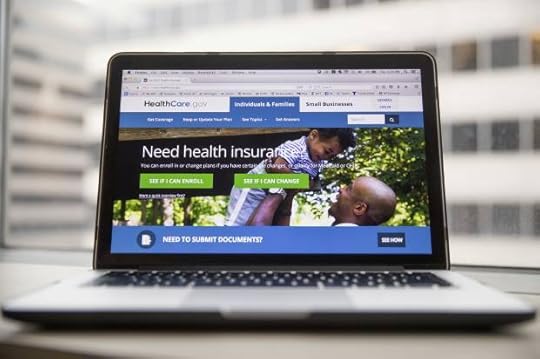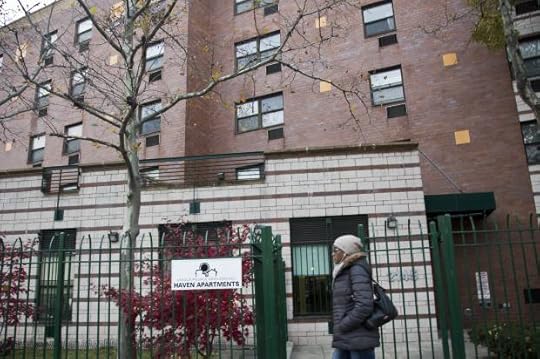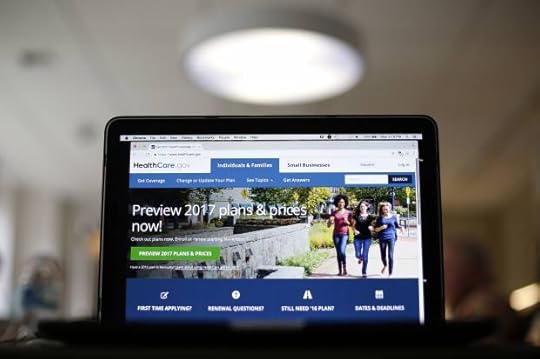Lily Salter's Blog, page 241
November 13, 2017
Why America’s future could look like a Renaissance painting

People look at Rembrandt's painting Portrait of a Couple as Isaac and Rebecca, known as 'The Jewish Bride.' (Credit: AP Photo/Kirsty Wigglesworth)
Bias for the super-rich, at the expense of everyone else, lies at the heart of the tax bill that Republicans hope to rush into law without public hearings. The most outrageous example of this is a plan to make sure that the richest of the rich never have to pay taxes on their investment gains.
The tax bill would not just eliminate the estate tax. It would do something far more outrageous.
The GOP/Trump tax plan would exempt all capital gains taxes from taxation at death.
That means Bill Gates, who started Microsoft with a $50,000 loan from his parents, would never be taxed on the increased value of stocks and other appreciated property he owns when his time runs out. Nor would his children, nor his children’s children. Ditto Warren Buffett, Jeff Bezos and Donald Trump.
This is how Old World-style, inherited aristocracies are created.
There is no policy justification for forgiving all capital gains at death. People should be demanding that this not come to pass unless they think the rich need more and are overly burdened by taxes—taxes they currently can defer until after they die. (For married couples, the taxes can be deferred until after the second spouse dies.)
The George W. Bush-era estate tax changes allowed an exemption for capital gains owed at death. But it was only for the taxes on $1.3 million of gains ($2.6 million for a married couple). That was bad policy, but at least it is limited to the modestly successful who saved and invested, not to people with fortunes in the billions and even tens of billions of dollars.
The reason the richest of the rich benefit is that only a minority of Americans own investments.
Most people who own stocks, real estate and other property that increases in value over time cash in their investments at various points in their lives. They pay capital gains taxes and on the after-tax balance they then pay for college for their children or pay off their mortgage or cover medical bills or cover living expenses in old age.
But if you own tens of millions or more in stocks—and a few Americans own tens of billions—you never need to sell these shares.
Indeed, during your lifetime you can borrow against them to cover your living expenses and never pay income taxes. Under the GOP and Trump tax plan, the super-rich can live tax-free and then pass their gains on to their heirs tax-free while you keep paying taxes.
This planned favor to the super-rich shifts the burden of supporting government off those who got the greatest economic benefit and adds it to the burdens of Americans who did less well in financial terms. It reminds us of what the late Leona Helmsley, a billionaire hotelier, said, according to a former housekeeper who testified at Helmsley’s 1989 income-tax evasion trial: “We don’t pay taxes; only the little people pay taxes.”
One of the most prominent tax advisers to the super rich is appalled by the bill. Jonathan Blattmachr is an estate tax lawyer so well known in his field that just mentioning his first name triggers recognition among the other 16,000 or so trust and estate lawyers. I featured Blattmachr in the opening of my book Perfectly Legal, still in print 14 years later.
Blattmachr, a card-carrying Republican, says the bill is rife with “bad, bad aspects” that amount to “a super giveaway to the rich and super-rich.”
The tax plan would add to the federal debt, which Trump ran against and which House Republicans have complained for years is a terrible economic monster that must be slain. But instead of a tax bill that would reduce the annual federal budget deficit or at least not add more than currently projected, the GOP plan will add an extra $1.5 trillion to the federal debt over a decade. The federal debt now stands at more than $20 trillion.
The increased debt will almost surely be used as justification by Republicans to cut spending. Their past plans have focused on reducing services for children, the disabled, the elderly, the hungry and the poor. In other words, the most vulnerable and least likely to fight back.
And if you own stocks through your retirement account, like an IRA or a 401(k), you not only get taxed on the gains when you sell, you pay at the higher rates for labor income rather than the lower rates applied to capital.
So, in simple terms, the plan is no taxes on the wealth of the richest of the rich, while you take on the added burden of supporting the government through more taxes, fewer services or more federal debt. Keep in mind these wise words from Blattmachr, an adviser to many of the super-rich:
“There is no such thing as tax reduction, only tax burden shifting. When you reduce taxes on the richest Americans, those less rich will pay the difference.”
After Hannity fans smash Keurig machines, CEO loses his nerve

Sean Hannity (Credit: AP/Carolyn Kaster)
In a companywide memo obtained by the media, Keurig CEO Bob Gamgort apologized to employees for attracting national, negative attention to the coffeemaker by creating the appearance that the brand was “taking sides” by pulling its advertising from Sean Hannity’s Fox News program.
The memo also placed the blame for the considerable backlash the brand has experienced since that decision on both Hannity and on the way it announced the move via social media.
Last week, Keurig made the not-unreasonable decision to stop advertising its products on “Hannity” after the host appeared to downplay allegations that Alabama Senate candidate Roy Moore had engaged in improper and illegal sexual relations with a 14-year-old girl.
On Saturday, the company announced the decision via a reply to an inquiry by Media Matters President Angelo Carusone, sent to the brand’s official Twitter account.
Angelo, thank you for your concern and for bringing this to our attention. We worked with our media partner and FOX news to stop our ad from airing during the Sean Hannity Show.
— Keurig (@Keurig) November 11, 2017
The company was only one of several that suspended its relationship with the host on a short or long-term basis for this very reason.
Fans of Hannity, Fox News, Moore and conservatism in general responded to the move with a flood of angry, polemical Twitter posts, some of which included videos and images of individuals smashing their Keurig coffeemakers.
Donald Trump Jr., son of President Donald Trump, joined this online groundswell by suggesting that the aggrieved instead purchase their grounds from Black Rifle Coffee Company, a pro-Trump, pro-gun, openly right-wing roaster.
Hannity, for his part, reveled in this outpouring of anger against the departed advertiser (and pledged to snap up some Black Rifle beans).
Now it appears that Keurig may be buckling under the pressure applied by these angry Keurig smashers.
The internal memo from Gamgort reveals that the CEO believes that, yes, Hannity is to blame, but concedes that it was a mistake to give consumers the impression that the brand was “‘taking sides'” on the fairly unnuanced issue of whether child rape is acceptable or not.
First, Gamgort addressed Hannity’s defense of Moore in the face of the accusations:
The catalyst for the current situation was commentary made by Sean Hannity on his TV and radio programs last week, which sparked a significant number of consumer complaints directed to us as advertisers on his TV program. Hannity himself later apologized for his comments in his own tweet: “As I said on TV tonight, I apologize when I misspoke and was not totally clear earlier today.”
The CEO added that:
In most situations such as this one, we would “pause” our advertising on that particular program and reevaluate our go-forward strategy at a later date. That represents a prudent “business as usual” decision for us, as the protection of our brand is our foremost concern.
Which all makes quite a lot of sense. From there, however, Gamgort blamed the particular Twitter rollout of Keurig’s “prudent ‘business as usual’ decision” for the negative backlash to its move:
However, the decision to publicly communicate our programming decision via our Twitter account was highly unusual. This gave the appearance of “taking sides” in an emotionally charged debate that escalated on Twitter and beyond over the weekend, which was not our intent.
I want you to know the decision to communicate our short-term media actions on Twitter was done outside of company protocols. Clearly, this is an unacceptable situation that requires an overhaul of our issues response and external communications policies and the introduction of safeguards to ensure this never happens again. Our company and brand reputations are too valuable to be put at risk in this manner.
There is some truth to the idea that announcing the decision via a reply to a pointed, opinionated tweet can give the impression that the brand did indeed “take a side” against Hannity and what he represents. However, the specific rollout of Keurig’s move isn’t why red meaters are smashing their pod machines like piñatas.
In truth, that has less to do with strategic marketing positioning and optimized brand engagement than it does with the unbridled fury some of Hannity’s viewers feel when they find their positions countered at any time in any way.
Moreover, Gamgort’s notion that the appearance that Keurig was “‘taking sides'” was problematic is a questionable one. It seemed fairly clear that Keurig had dropped Hannity due to his initial comments in defense of a candidate who is, again, accused of sexually assaulting a legal minor against her will (and has been accused by more women since). Exactly how a brand would benefit from not upsetting those on the other “side” of that particular issue is unclear.
Of course, in our the current, highly polarized, completely gamified political discourse, making a stand against Hannity’s initial comments mounts to taking stand against conservatism itself. This is the way things work now.
Monday afternoon, Hannity, claimed a measure of victory after Gamgort’s memo came to light, saying incorrectly that Keurig now understood that it was “misled” by Carusone, who he has labeled an “anti free speech bigot.”
Hold on to your coffee machines @keurig has recognized it got caught up & misled by a bigot. Still giving away coffee machines, which brand has yet to be determined. Stay tuned. https://t.co/Af1FUCa3Br — Sean Hannity (@seanhannity) November 13, 2017
Again, this is the way things work now.
6 cities harmed by AirBnb’s brand of gentrification

(Credit: AP Photo/Bebeto Matthews, File)
The share economy has democratized travel for many, making it cheaper to explore new places while supposedly providing guests with more personal service than they would receive from hotel chains or taxi cabs. But it’s no secret that the ever-popular AirBnb has caused damage since launching almost 10 years ago. Airbnb has amplified the problem of gentrification in some of its most popular destinations. Small historic cities, many of whose central districts were designed hundreds of years ago for much smaller populations, are particularly feeling the crunch.
When residents list their apartments on AirBnb, these neighborhoods can become overcrowded and prompt landlords to raise rents, making it more difficult for longtime residents to afford the pricey real estate. Unlike New York City, whose legal fight against the tech company has been largely prompted by a lobby of hotel chains hurting from the competition, plenty of other cities have fought, or are currently waging, their own battles against AirBnb for an arguably nobler cause: their hard-hit middle class. Here are six cities that have been particularly impacted.
1. San Francisco
The Airbnb gentrification controversy may have launched in 2014 in the tech company’s own hometown when a San Francisco man sued his landlord for wrongful eviction after the landlord reportedly kicked him out of his apartment in order to make space for Airbnb guests. The landlord realized she could charge tourists $125 to $145 a night for the apartment, instead of the $1840 a month the plaintiff had been paying for years prior. It’s not an uncommon story in San Francisco, already one of the most expensive cities in the country facing severe and rapid gentrification. “We have a dwindling stock of rent-controlled units in San Francisco,” Steven Jones, editor-in-chief of the San Francisco Bay Guardian, told Slate in 2014. “Any of those precious few units going to visiting tourists rather than permanent residents certainly adds to the housing crisis here.”
2. Berlin
Berlin was one of the earliest to wage a legal battle against Airbnb, after rents rose by 8% between 2012-2013 when the site helped bring in a rush of tourists. Its effects were especially felt in the famously inexpensive neighborhoods of the German capital, which has been a bohemian mecca for struggling artists. “Berlin was an extraordinarily affordable place for the past 10 years,” one Airbnb host told Christian News & Wire. “But everyone knew that wouldn’t always be the case.”
3. Paris
It’s one of the most popular destinations on Airbnb, with 40,000 properties listed in 2015compared to 16,000 in New York. To counter a rent hike, local government began fining Parisians up to 25,000 euros for violating a no-Airbnb rule that year. The housing advisor to Paris’ mayor told Bloomberg “We can’t have entire neighborhoods or buildings turned into tourist homes…that’s why we’re fighting to keep Parisians inside Paris and we won’t let tourist rentals eat up their space.”
4. New Orleans
In a city where tourists outnumber residents 25 to 1 in peak months, New Orleans’ government has been under pressure for some time to limit the influx of Airbnbers. In 2016, the city council voted to ban Airbnb in most of the historic French Quarter, especially targeting those they classified as “bad actors,” or “short-term rental hosts who rent to large groups of people who throw noisy parties and cause trouble in neighborhoods,” as the Times-Picayune put it.
5. Florence
Residents of the ancient city have taken a beating from Airbnb-fueled gentrification in recent years. The Telegraph reports that almost 20 percent of residential space in the historic city center of Florence is listed on the site. Locals, increasingly strained by the subsequent rise in rents, are being pushed out. The influx of tourists to the city center has changed the cultural character of the city as well. As Stefano Picascia of the University of Siena said, “The center of Florence is now Disneyfied. It’s basically a theme park for tourists.”
6. Barcelona
Other European cities with geographically small historic center districts are feeling a similar crunch. Tourism in Barcelona skyrocketed to 34 million visitors in 2016, up 25 percent from 2012, according to the Independent, and Airbnb has similarly been linked to rent hikes. Barcelona landlords raised housing costs by an astonishing 16.5 percent in 2016.
The mystery of a 1918 veteran and the flu pandemic

(Credit: AP Photo/National Museum of Health, File)
Vaccination is underway for the 2017-2018 seasonal flu, and next year will mark the 100-year anniversary of the 1918 flu pandemic, which killed roughly 40 million people. It is an opportune time to consider the possibility of pandemics — infections that go global and affect many people — and the importance of measures aimed at curbing them.
The 1918 pandemic was unusual in that it killed many healthy 20- to 40-year-olds, including millions of World War I soldiers. In contrast, people who die of the flu are usually under five years old or over 75.
The factors underlying the virulence of the 1918 flu are still unclear. Modern-day scientists sequenced the DNA of the 1918 virus from lung samples preserved from victims. However, this did not solve the mystery of why so many healthy young adults were killed.
I started investigating what happened to a young man who immigrated to the U.S. and was lost during World War I. Uncovering his story also brought me up to speed on hypotheses about why the immune systems of young adults in 1918 did not protect them from the flu.
The 1918 flu and World War I
Certificates picturing the goddess Columbia as a personification of the U.S. were awarded to men and women who died in service during World War I. One such certificate surfaced many decades later. This one honored Adolfo Sartini and was found by grandnephews who had never known him: Thomas, Richard and Robert Sartini.
The certificate was a message from the past. It called out to me, as I had just received the credential of certified genealogist and had spent most of my career as a scientist tracing a gene that regulates immune cells. What had happened to Adolfo?
A bit of sleuthing identified Adolfo’s ship listing, which showed that he was born in 1889 in Italy and immigrated to Boston in 1913. His draft card revealed that he worked at a country club in the Boston suburb of Newton. To learn more, Robert Sartini bought a 1930 book entitled “Newton War Memorial” on eBay. The book provided clues: Adolfo was drafted and ordered to report to Camp Devens, 35 miles from Boston, in March of 1918. He was later transferred to an engineer training regiment.
To follow up, I posted a query on the “U.S. Militaria Forum.” Here, military history enthusiasts explained that the Army Corps of Engineers had trained men at Camp A. A. Humphreys in Virginia. Perhaps Adolfo had gone to this camp?
While a mild flu circulated during the spring of 1918, the deadly strain appeared on U.S. soil on Tuesday, Aug. 27, when three Navy dockworkers at Commonwealth Pier in Boston fell ill. Within 48 hours, dozens more men were infected. Ten days later, the flu was decimating Camp Devens. A renowned pathologist from Johns Hopkins, William Welch, was brought in. He realized that “this must be some new kind of infection or plague.” Viruses, minuscule agents that can pass through fine filters, were poorly understood.
With men mobilizing for World War I, the flu spread to military installations throughout the U.S. and to the general population. It hit Camp Humphreys in mid-September and killed more than 400 men there over the next month. This included Adolfo Sartini, age 29½. Adolfo’s body was brought back to Boston.
His grave is marked by a sculpture of the lower half of a toppled column, epitomizing his premature death.
The legacy of victims of the 1918 flu
The quest to understand the 1918 flu fueled many scientific advances, including the discovery of the influenza virus. However, the virus itself did not cause most of the deaths. Instead, a fraction of individuals infected by the virus were susceptible to pneumonia due to secondary infection by bacteria. In an era before antibiotics, pneumonia could be fatal.
Recent analyses revealed that deaths in 1918 were highest among individuals born in the years around 1889, like Adolfo. An earlier flu pandemic emerged then, and involved a virus that was likely of a different subtype than the 1918 strain. These analyses engendered a novel hypothesis, discussed below, about the susceptibility of healthy young adults in 1918.
Exposure to an influenza virus at a young age increases resistance to a subsequent infection with the same or a similar virus. On the flip side, a person who is a child around the time of a pandemic may not be resistant to other, dissimilar viruses. Flu viruses fall into groups that are related evolutionarily. The virus that circulated when Adolfo was a baby was likely in what is called “Group 2,” whereas the 1918 virus was in “Group 1.” Adolfo would therefore not be expected to have a good ability to respond to this “Group 1” virus. In fact, exposure to the “Group 2” virus as a young child may have resulted in a dysfunctional response to the “Group 1” virus in 1918, exacerbating his condition.
Support for this hypothesis was seen with the emergence of the Hong Kong flu virus in 1968. It was in “Group 2” and had severe effects on people who had been children around the time of the 1918 “Group 1” flu.
To 2018 and beyond
What causes a common recurring illness to convert to a pandemic that is massively lethal to healthy individuals? Could it happen again? Until the reason for the death of young adults in 1918 is better understood, a similar scenario could reoccur. Experts fear that a new pandemic, of influenza or another infectious agent, could kill millions. Bill Gates is leading the funding effort to prevent this.
Flu vaccines are generated each year by monitoring the strains circulating months before flu season. A time lag of months allows for vaccine production. Unfortunately, because the influenza virus mutates rapidly, the lag also allows for the appearance of virus variants that are poorly targeted by the vaccine. In addition, flu pandemics often arise upon virus gene reassortment. This involves the joining together of genetic material from different viruses, which can occur suddenly and unpredictably.
An influenza virus is currently killing chickens in Asia, and has recently killed humans who had contact with chickens. This virus is of a subtype that has not been known to cause pandemics. It has not yet demonstrated the ability to be transmitted from person to person. However, whether this ability will arise during ongoing virus evolution cannot be predicted.
The chicken virus is in “Group 2.” Therefore, if it went pandemic, people who were children around the time of the 1968 “Group 2” Hong Kong flu might have some protection. I was born much earlier, and “Group 1” viruses were circulating when I was a child. If the next pandemic virus is in “Group 2,” I would probably not be resistant.
 It’s early days for understanding how prior exposure affects flu susceptibility, especially for people born in the last three to four decades. Since 1977, viruses of both “Group 1” and “Group 2” have been in circulation. People born since then probably developed resistance to one or the other based on their initial virus exposures. This is good news for the near future since, if either a “Group 1” or a “Group 2” virus develops pandemic potential, some people should be protected. At the same time, if you are under 40 and another pandemic is identified, more information would be needed to hazard a guess as to whether you might be susceptible or resistant.
It’s early days for understanding how prior exposure affects flu susceptibility, especially for people born in the last three to four decades. Since 1977, viruses of both “Group 1” and “Group 2” have been in circulation. People born since then probably developed resistance to one or the other based on their initial virus exposures. This is good news for the near future since, if either a “Group 1” or a “Group 2” virus develops pandemic potential, some people should be protected. At the same time, if you are under 40 and another pandemic is identified, more information would be needed to hazard a guess as to whether you might be susceptible or resistant.
Rising health insurance costs frighten some early retirees

This Thursday, Feb. 9, 2017 photo shows the HealthCare.gov website, where people can buy health insurance, displayed on a laptop computer screen in Washington. (Credit: AP Photo/Andrew Harnik)
Don and Debra Clark of Springfield, Mo., are glad they have health insurance. Don is 56 and Debra is 58. The Clarks say they know the risk of an unexpected illness or medical event is rising as they age and they must have coverage.
Don is retired and Debra works part time a couple of days a week. As a result, along with about 20 million other Americans, they buy health insurance in the individual market — the one significantly altered by the Affordable Care Act (ACA).
But the Clarks are not happy at all with what they pay for their coverage — $1,400 a month for a plan with a $4,500 deductible. Nor are they looking forward to the ACA’s fifth open enrollment period, which runs from Wednesday through Dec. 15 in most states. Many insurers are raising premiums by double digits, in part because of the Trump administration’s decision to stop payments to insurers to cover the discounts they are required to give to some low-income customers to cover out-of-pocket costs.
“This has become a nightmare,” said Don Clark. “We are now spending about 30 percent of our income on health insurance and health care. We did not plan for that.”
Karen Steininger, 62, of Altoona, Iowa, said her ACA coverage not only gave her peace of mind but also helped her and her husband, who is now on Medicare, stay in business the past few years. But they too are concerned about rising costs and the effect of the president’s actions.
The Steiningers are self-employed owners of a pottery studio. Their income varies year to year. They now pay $245 a month for Karen’s subsidized coverage, which, like the Clarks’, has a $4,500 deductible. Without the government subsidy, the premium would be about $700 a month.
“What if we make more money and get less of a subsidy or just if the premiums increase a lot?” Karen Steininger asked. “That would be a burden. We’ll have to cut back on something or switch to cheaper coverage.”
The experiences of the Clarks and the Steiningers point to an emerging shortfall in the ACA’s promise of easier access to affordable health insurance for early retirees and the self-employed. Rising premiums and deductibles, recent actions by the Trump administration, and unceasing political fights over the law threaten those benefits for millions of older Americans.
“These folks are rightly the most worried and confused right now,” said Kevin Lucia, a health insurance specialist and research professor at Georgetown University’s Health Policy Institute in Washington, D.C. “Decisions about which health plan is best for them is more complicated for 2018, and many people feel more uncertain about the future of the law itself.”
At highest risk are couples like the Clarks who get no government subsidy (which comes in the form of an advanced tax credit) when they buy insurance. That subsidy is available to people earning up to 400 percent of the federal poverty level, or just under $65,000 for a couple. Their income is just above the amount that would have qualified them for a subsidy in 2017.
Premiums vary widely by state. Generally, a couple in their late 50s or early 60s with an annual income of $65,000 would pay from $1,200 to $3,000 a month for health insurance.
Premiums rose an average 22 percent nationwide in 2017 and are forecast to rise between 20 and 30 percent overall for 2018.
In an analysis released this week based on insurers’ rate submissions for 2018, the Kaiser Family Foundation found that individuals and families that don’t qualify for a subsidy but are choosing plans on the federal marketplace face premiums 17 to 35 percent higher next year, depending on the type of plan they choose. (Kaiser Health News is an editorially independent program of the foundation.)
A similar increase would be expected for people who also buy on the marketplaces run by some states or buy directly from a broker or insurance company.
The substantial premium increases two years in a row could lead fewer people to buy coverage.
“I’m really worried about this,” said Peter Lee, CEO of Covered California, the exchange entity in that state. “We could see a lot fewer people who don’t get subsidies enroll.” He said that California has taken steps to mitigate the impact for people who don’t get subsidies but that “consumers are very confused about what is happening and could just opt not to buy.”
There are already signs of that, according to an analysis for this article by the Commonwealth Fund. The percentage of 50- to 64-year-olds who were uninsured ticked up from 8 percent in 2015 to 10 percent in the first half of 2017. In 2013, the figure was 14 percent.
Indeed, the ACA has been a boon to people in this age group whether they get a subsidy or not. It barred insurers from excluding people with preexisting conditions — which occur more commonly in older people. And the law restricted insurers from charging 55- to 64-year-olds more than three times that of younger people, instead of five times more, as was common.
The law also provided much better access to health insurance for early retirees and the self-employed — reducing so-called “job lock” and offering coverage amid a precipitous decline in employer-sponsored retiree coverage that began in the late 1990s.
Only 1 in 4 companies with 200 or more workers offered any kind of coverage to early (pre-65) retirees in 2017 compared with 66 percent of firms in 1988, reported the Kaiser Family Foundation. And the vast majority of small firms never did offer such coverage.
Overall, before the ACA became law, 1 in 4 55- to 64-year-olds buying coverage on their own either couldn’t get it at all because of a preexisting condition or couldn’t afford it, according to AARP.
“The aging but pre-Medicare population was our major reason to support the ACA then and it still is now,” said David Certner, director of legislative policy at AARP. “This group benefited enormously from the law, and we think society and the economy benefited, too.”
Just how many 55- to 64-years-olds have been liberated from job lock by the ACA has yet to be fully assessed. But recent data show that 18 percent of people ages 55 to 64 who were still working in 2015 got coverage through the ACA marketplaces, up from 11.6 percent in 2013, according to an analysis for this article by the Employee Benefit Research Institute.
Also, a report released in January 2017 by the outgoing Obama administration found that 1 in 5 ACA marketplace enrollees of any age was a small-business owner or self-employed person.
A bipartisan effort is underway in Congress to provide dedicated funds to woo enrollees to healthcare.gov and help state agencies explain changes in the law for 2018 triggered by the Trump administration. But the fate of the proposed legislation is uncertain.
The Clarks said they’ll look carefully at options to keep their premiums affordable in 2018.
Said Don Clark, “If we get to a point where we have a $10,000 deductible and pay 40 percent or more of our income for health insurance, I’m not sure what we’ll do. We can’t afford that.”
November 12, 2017
10 most violent video games of 2017 (and what to play instead)

(Credit: AP Photo/M. Spencer Green)
It’s a dark night. You’ve just escaped from a sprawling mansion deep in the Louisiana bayou. You’re terrified. You’ve been shot at, bludgeoned, and stabbed as you try to escape this life-or-death situation. What’s worse, it looks like you’re on your own, because a sheriff’s deputy was killed in front of your eyes. You take a break in an upstairs bathroom to catch your breath, but something doesn’t feel right. You should go, but as you get to the door, it swings open, and you’re face to face with the man you killed minutes before. How is he still alive, and worse, how are you ever going to escape if you have to kill him again and again?
This is only one of the many nightmare-inducing, pulse-pounding, and incredibly violent moments from the horror-survival game Resident Evil 7 Biohazard. RE7, as it’s known to fans, tosses an ordinary guy into a macabre setting full of monsters and mayhem that terrifies even the most hardcore horror gamers. But it’s more than just jump scares and shrill music that’s designed to make players uneasy. Sometimes, the content of the game itself can be too much for many gamers to handle.
Every year, game graphics become more realistic and immersive, bringing players closer to the action and story than ever before. With violent video games, this realism ratchets up the brutality. Despite that, video game promotions target kids way younger than the games’ age rating. Trailers, demos, blogs, and more air on TV, go viral on social media, and are discussed endlessly on game sites. Marketers advertise the excitement, the depth of realism, and the cool gameplay — but they often don’t tell you exactly how violent the games are. The truth is, the majority of the hyper-realistic, hyper-popular games are best left to mature players. The impact of violent media on kids is still being studied — especially as game violence jumps from the screen to virtual reality. But research shows that heavy exposure to violent media is associated with aggressive behavior, desensitization, and violent thoughts.
Many parents whose kids ask for these games (or set up a line of credit on game sites such as Steam) may know that the games are violent, but not the specific kinds of violence they contain. Here’s where you can find out. Below, we’ve gathered 10 of the most extreme titles to come out this year. A lot of them are well-designed gameplay experiences, but they’re definitely not for kids. The thing is, instead of saying no all the time, we think you’ll be more successful if you say, “Wait,” and offer kids alternatives in the same genre that are a little less violent and more age-appropriate. Note that we offer two alternatives for each game, one for younger players and one for older players.
If you don’t want any violence in your games, be sure to check out our list of nonviolent games, Nonviolent Games for Xbox One, Nonviolent Games for Wii U, and Nonviolent Games for PS4 — and always check out our reviews on the latest games.
Bulletstorm: Full Clip Edition
Few sci-fi action games push the envelope as much as Bulletstorm, which focuses on players using guns, kicks, and an electric whiplike device to destroy their opponents. There’s plenty of blood, gore, and dismemberment, and players get points for killing enemies in extreme ways.
Alternative sci-fi action: ReCore: Definitive Edition (12+), Gravity Rush 2 (14+)
Conan Exiles
This massively multiplayer online role-playing game is full of bloody, gory hack-and-slash action that includes decapitations and dismemberment. Other game events highlight the brutality of Conan’s world, its environment, and its subject matter, which includes cannibalism, torture, and human sacrifice.
Alternate MMOs: Guild Wars 2: Heart of Thorns (12+), Marvel Heroes 2016 (13+)
Dark Souls III: The Ringed City
The end of this incredibly difficult action role-playing game franchise doesn’t skimp on the blood, gore, or shock factor, as fantasy creatures moan and gush blood when struck by medieval weapons. Bodies are frequently seen scattered throughout the environment, and players will slash, impale, and smash enemies to pieces.
Alternate action RPGs: The Legend of Zelda: Breath of the Wild (10+), Horizon Zero Dawn (13+)
Dead by Daylight
In this slasher game, a remorseless killer hunts down survivors to sacrifice them to an evil entity, using a variety of weapons to hack, stab, and impale characters. Injured players may crawl on the ground leaving pools of blood behind and can be hung on meat hooks in brutal death sequences.
Alternative scary games: Five Nights at Freddy’s 4 (12+), Darkest Dungeon (16+)
For Honor
Combat between three factions plays a major role in this action fighting game set in a medieval fantasy world. Each entity tries to assert its dominance over the others using melee weapons, such as swords, pikes, and spears. Kills are frequently shown in close-up with large splashes of blood, while plenty of arenas show severed heads on spikes and other gruesome imagery. Players also slaughter dozens, if not hundreds of computer-controlled enemies wholesale with no ability to negotiate peace.
Alternate multiplayer action games: Portal Knights (10+), Fortnite (13+)
Friday the 13th: The Game
Like a digital version of the horror movie franchise, this multiplayer slasher game places one player in the role of Jason hunting down and killing opponents, who assume the roles of different camp counselors. Adding a sexual angle to the violence (a potentially harmful combination for tweens and teens), the female characters are scantily clad or skinny-dipping while they are being hunted down. Grisly violence abounds as characters are killed with weapons, environmental objects, or even Jason’s bare hands. The cut scenes and gameplay feature tons of blood and gore.
Alternative action games: Cuphead (10+), Alan Wake (14+)
Outlast II
Gory scares run throughout this bloody horror game, which forces players to try their best to escape from cultists wielding weaponry and farm implements. These enemies only want to catch and torture the player in bloody, gruesome ways, and multiple scenes of viscera and stabbing are frequently shown, as well as the violent birth of the Antichrist.
Alternate scary games: Luigi’s Mansion: Dark Moon (9+), Zombie Vikings (13+)
PlayerUnknown’s Battlegrounds
Gamers try their best to be the last one standing in this online shooter, which throws up to 100 players into a constantly shrinking arena. Whether using firearms, cars, melee weapons, or bare hands, you have to try to kill everyone you come across to ensure your safety. Even alliances between players can quickly be tossed aside in favor of points and survival, undermining the concepts of cooperation, loyalty, and teamwork.
Alternative shooters: Hard Reset Redux (10+), Destiny 2 (13+)
Resident Evil 7 Biohazard
Scares aren’t the only thing to shock gamers in this violence-packed game that glorifies cruelty as players use shotguns, chainsaws, explosives, and other weapons against human and inhuman creatures. There are plenty of disturbing images of open wounds and injuries, and characters are dismembered, impaled, or killed in brutal ways.
Alternative survival action games: Plants Vs. Zombies: Garden Warfare 2 (10+), Adr1ft (13+)
Sniper Elite 4
War games frequently highlight massive casualties, but this World War II shooter casts the player as a sniper. Using knives, explosives, and a variety of firearms, you travel to some of the most dangerous locations of the war to conduct stealthy attacks against Nazi soldiers. Unfortunately, there aren’t any nonviolent attack options, so these strikes are simply ways to kill enemies without poking the ant hill of enemies that scour the grounds looking for you once they’ve detected something’s amiss. On top of this, some kills are slowed down and highlighted with graphic X-ray visuals indicating the brutality of the damage inflicted on its target from a fired bullet.
Alternative shooter games: Splatoon 2 (10+), Overwatch (13+)
Chinese philosophers can teach us about dealing with grief

(Credit: Leah Hogsten /The Salt Lake Tribune via AP)
November 2 is All Souls’ Day, when many Christians honor the dead. As much as we all know about the inevitability of death, we are often unable to deal with the loss of a loved one.
Our modern-day worldview could also make us believe that loss is something we should be able to quickly get over, to move on with our lives. Many of us see grieving as a kind of impediment to our ability to work, live and thrive.
As a scholar of Chinese philosophy, I spend much of my time reading, translating and interpreting early Chinese texts. It is clear that dealing with loss was a major concern for early Chinese philosophers.
So, what can we learn from them today?
Eliminating grief

Zhuangzi butterfly dream.
Ike no Taiga (Japan, 1723-1776), via Wikimedia Commons
Two influential philosophers who reflected on these issues were Zhuang Zhou and Confucius. Zhuang Zhou lived in the fourth century B.C. and is traditionally credited with writing one of the most important texts of the Daoist philosophy, “Zhuangzi.” Confucius, who lived more than a century before Zhuang Zhou, had his teachings compiled in a text written by later students, commonly known in the West as the “Analects of Confucius.”
On the face of it, these two philosophers offer very different responses to the “problem” of death.
Zhuang Zhou offers us a way to eliminate grief, seemingly consistent with the desire to quickly get beyond loss. In one story, Zhuang Zhou’s friend Hui Shi meets him just after Zhuang Zhou’s wife of many years has died. He finds Zhuang Zhou singing joyously and beating on a drum. Hui Shi upbraids him and says:
“This person lived with you for many years, and grew old and died. To fail to shed tears is bad enough, but to also beat on drums and sing – is this not inappropriate?”
Zhuang Zhou replies that when his wife first died, he was as upset as anyone would be following such a loss. But then he reflected on the circumstances of her origins – how she came to be through changes in the elements that make up the cosmos. He was able to shift his vision from seeing things from the narrowly human perspective to seeing them from the larger perspective of the world itself. He realized that her death was just another of the changes of the myriad things constantly taking place in the world. Just as the seasons progress, human life generates and decays.
In reflecting on life in this way, Zhuang Zhou’s grief disappeared.
Why we need grief

Analects.
Confucius and his disciples, via Wikimedia Commons
For Confucius, though, the pain of grief was a natural and necessary part of human life. It demonstrates commitment to those for whom we grieve.
Confucius suggests a three-year mourning period following the death of one’s parent. In a passage from the Analects, one of Confucius’s students, Zaiwo, asks him if it is possible to shorten this mourning period, which seems excessively long.
Confucius responds that a person who honestly cared about his parent would simply be unable to bring himself to mourn in any less serious way. For such a person, the usual joys of life just had no attraction for three years. If, like Zaiwo, someone considers shortening this period, it reveals for Confucius a lack of sufficient concern. Early Confucians, thus, followed this practice of a three-year mourning period.
Remembering our ancestors
There is more to the Confucian response to death than grief. Our encounter with others inevitably changes us. Those closest to us, according to the early Confucians, particularly family members, play the greatest role in determining who we are. In that sense, we are representatives of particular communities than detached and autonomous individuals.
After all, many of our physical features and personalities originate from our ancestors. In addition, we learn many of our attitudes, preferences and characteristic ways of acting from our families, friends and neighbors – the creators of our culture. So, when we consider the question of what we are as individuals, the answer necessarily encompasses members of our closest community.

A Chinese funeral.
Scan by NYPL, via Wikimedia Commons
According to the early Confucians, this acknowledgment suggested how to deal with the death of those close to us. To grieve was to honor your parent or another person who died and to commit to following their way of life .
Even if their way of life involved flaws, Confucius notes that individuals were still duty-bound to follow their way while doing their best to eliminate the flaws. In Analects 4.18, Confucius says:
“In serving your parents, you may lightly remonstrate [if your parents stray from the virtuous way]. But even if your parents are intent on not following your advice, you should still remain respectful and not turn away from them.”
Developing an understanding of grief
So how do the seemingly contrasting Daoist and Confucian approaches to grief apply to us today?
From my perspective, both views are helpful. Zhuangzi does not eliminate grief, but offers a way out of it. The Daoist response could help people find peace of mind by cultivating the ability to see the death of loved ones from a broader perspective.
The Confucian response could challenge assumptions that devalue grief. It offers us a way to find meaning in our grief. It reveals our communal influences, tests our commitments and focuses us on the ways in which we represent and carry on those who influenced us and came before us.
 Ultimately, both philosophers help us understand that enduring grief is a necessary part of the process of becoming a fully thriving person. It is not something we should look to eliminate, but rather something we should appreciate or even be thankful for.
Ultimately, both philosophers help us understand that enduring grief is a necessary part of the process of becoming a fully thriving person. It is not something we should look to eliminate, but rather something we should appreciate or even be thankful for.
Alexus McLeod, Associate Professor of Philosophy and Asian/Asian American Studies, University of Connecticut
Are the Syrian Kurds next for betrayal by the Trump administration?

(Credit: Mursel Coban/Depo Photos via AP, File)
Iraqi Kurds were attacked in Kirkuk by Iranian-backed Shiite militias on October 15. Despite decades of close cooperation between Iraqi Kurdistan and the United States, the U.S. abandoned Iraqi Kurds who, at America’s behest, have fought bravely against the Islamic State. Syrian Kurds fear they are next for betrayal by the Trump administration.
Abandoning the Syrian Kurds would be a flawed and short-sighted move. Flawed because the Peoples Protection Units (YPG), who number 40,000 men and women under arms, are proven and effective fighters against the Islamic State (ISIS). Short-sighted because it would align the United States with Iran and its allies in Baghdad and Damascus as primary partners in the coalition to defeat ISIS.
YPG fighters have served as America’s boots-on-the-ground in Syria. They liberated Raqqa, the self-declared ISIS caliphate. U.S. Special Forces, weapons, and air power coordinated with the YPG and were invaluable.
Cooperation dates back to the battle for Kobani in October 2014. About 80 percent of Kobani, a Kurdish city in Northern Syria, had been seized by ISIS. Kobani’s heroic defenders were outmatched and almost out of ammunition. U.S. officials initially believed that Kobani had no strategic value, but they reconsidered. The Obama administration decided it would be a recruitment bonanza if Kobani fell and its defenders were beheaded for all the world to see. Turning the tide, the U.S. airlifted weapons to the YPG and bombed ISIS positions.
Recognizing the YPG’s battlefield prowess, America supported the YPG’s march against ISIS territory. The YPG seized the strategic border crossing at Tal-Abyad, preventing Turkey from sending weapons to ISIS in Raqqa. It secured the main road to Raqqa in June 2015. Then it took a border town in northwestern Syria called Azaz, before pivoting towards Raqqa.
Turkey’s President Tayyip Erdogan was furious. He fumed, “Is it me who is your partner or the terrorists in Kobani?” Erdogan alleged that the YPG and the PKK were one and the same organization. Both Turkey and the United States consider the PKK a foreign terrorist organization (FTO). However, the State Department does not list the Democratic Union Party, the YPG’s political arm, as an FTO.
Over Erdogan’s objections, the Pentagon decided to provide heavy and offensive weapons directly to the YPG in May 2017. U.S. military commanders concluded that arming the YPG was the fastest way to take Raqqa. The Syrian Democratic Forces (SDF) served as a fig leaf, engaging anti-Assad Arabs.
The decision was pivotal. On October 20, 2017, after 130 days of intense fighting, the YPG/SDF declared the “total liberation” of Raqqa. YPG ground forces paid a steep price. Since 2014, nearly four thousand YPG members died fighting ISIS. About a quarter of the casualties were women fighters.
U.S. Brigadier General Jonathan Braga praised “a highly effective, professional operation in a difficult urban area to free the city.” Secretary of State Rex Tillerson extolled Raqqa’s liberation as a “new phase” in Syria.
Syrian Kurds are cautious. They fear that the new phase may be to their disadvantage. Is the Trump administration’s betrayal of Iraqi Kurds a harbinger of what may happen to them?
Syrian Kurds worry Washington could bend to Turkey’s demand and declare the YPG a terror group. In this event, the Pentagon would discontinue the supply of weapons and air power. U.S. Special Forces would withdraw. Abandoning the Syrian Kurds would further stain America’s standing. Moreover, it would be a strategic blunder. Without U.S. backing, Syrian Kurds could turn to Russia for protection or seek common cause with Syria’s President Bashar al-Assad. Cutting the Kurds loose would be interpreted by Turkey as a green light to invade Northern Syria in a bid to undermine Rojava, an autonomous area in the provinces of Afrin, Kobani, and Jazeera.
Kurds are uncertain. Can they trust the Trump administration? Is America’s cooperation simply expedient? The specter of betrayal will make Syrian Kurds and other partners think twice when called upon to fight and die for the United States.
How the proposed budget could stunt new affordable housing

(Credit: AP Photo/Bebeto Matthews)
Low-income Americans are already struggling to keep a roof over their heads due to a growing affordable housing shortage.
But budgets drafted by the Trump administration and Congress, along with provisions in the tax cut package, are bound to make matters worse.
As a researcher who studies the intersection of tax law and housing policy, I am concerned about how these proposed changes would reduce the volume of new housing for low-income people and cut aid that people facing economic hardship use to cover their rent.
Spending on housing
The federal government stopped building public housing two decades ago after years of declining construction. Although it has demolished many of these homes, the government continues to own and rent out about 1.1 million of these units.
Nowadays, the government mostly seeks to help make privately owned and operated housing affordable by providing rental assistance to low-income tenants. The main way it does that is by funding the US$19.3 billion Housing Choice Voucher program through which eligible tenants get help paying their rent.
The federal government also subsidizes the construction of privately owned and operated housing units that are officially designated as “affordable.” Private sector developers who build or rehabilitate affordable housing projects do so with the aid of the federal low-income housing tax credit.
In the U.S., affordable housing is defined as dwellings that cost less than 30 percent of low-income tenants’ income for rent and utilities or the owners’ mortgage, property taxes, homeowners’ insurance and utilities — based on regional median income levels.
The tax credit, which has provided about $8 billion in subsidies for new affordable housing projects each year, has financed about 3 million new or rehabbed homes since 1987.
In addition, municipal and state debt governments often issue “private activity bonds” to finance low-income housing — as well as student loan programs, hospitals and big infrastructure projects like bridges and highways. Until now, these bonds have been exempt from federal taxes.
Not enough
The supply of affordable housing is so low that there is no state, city or county in the country where a full-time minimum wage employee can afford to rent a two-bedroom unit, according to the National Low Income Housing Coalition, an advocacy group.
And the department of Housing and Urban Development says that the number of low-income families paying more than half their income for rent or living in severely inadequate housing conditions without help from the government is nearing record levels.
As of 2015, roughly 20 million American households (excluding the homeless) were officially eligible for housing assistance. But nearly 75 percent of them did not get this help because of a lack of funds.
Meanwhile, a new study by Freddie Mac, a government-owned company that buys mortgages from lenders, found that the number of affordable housing units has plunged over the last 15 years. The study focused on the affordability of rental units in buildings that were both financed by Freddie Mac and refinanced during that same period.
In those buildings, the share of rental units affordable to very low-income renters — people living on an income that is less than half of their area’s median, adjusted for their household size and local economy — dropped from 11.2 percent to 4.3 percent.
Calling the results “striking,” Freddie Mac speculated that the trend reflected a combination of increasing rents, stagnant incomes and potential changes to housing subsidies.
Curbing help
These housing woes are sure to become more dire.
One reason for this is that the proposed tax-cut package would abolish private activity bonds. These bonds currently help pay for the construction of more than 40 percent of new affordable housing units.
Less obviously, current tax reform proposals also stand to reduce the effectiveness of the low-income housing tax credit. While GOP lawmakers are not aiming to end the tax credit as part of their package of tax changes, the low corporate tax rates proposed in the tax bill before Congress would surely reduce the value of the tax credits.
The reason for this grim outlook has to do with the complicated way low-income housing tax credits work.
To spur new affordable housing projects, the tax credits must deliver a meaningful subsidy to housing developers. But developers usually don’t use the tax credits directly. Instead, they sell the right to use the credits to banks and other investors. The investors essentially purchase the tax credits at a discount. The lower the price falls, the less value the developer receives.
The price that investors are paying to use the tax credits has already plummeted in anticipation of reduced tax rates, leaving developers unable to secure the funding they need to produce affordable housing. One expert analysis estimates that the proposed tax cuts could lead to 1 million fewer affordable housing units being produced over the next 10 years — about a third of what is currently produced.
Simple and stark
While the budget bills approved by the House and the Senate do not slice $6 billion from HUD’s budget, as the Trump administration tried to do in its spending proposal, they would still leave more American families unable to afford a roof over their heads.
The relatively generous Senate version of the housing line items appears likely to prevail as a way to make way for the tax overhaul. Even so, every state would have less money for housing vouchers, according to the Center for Budget and Policy Priorities, a think tank that researches safety net programs.
Perhaps this all sounds technical and complicated. But the outcome for many low-income Americans will be simple and stark.
 The proposed tax changes that make it harder to finance new affordable housing units, combined with proposed cuts to tenant voucher programs, will increase the risk of becoming homeless and take a toll on the poor.
The proposed tax changes that make it harder to finance new affordable housing units, combined with proposed cuts to tenant voucher programs, will increase the risk of becoming homeless and take a toll on the poor.
A cheat sheet for the trickiness of shopping for Obamacare

FILE - This Oct. 24, 2016, file photo, shows the HealthCare.gov 2017 website home page on a laptop in Washington. Health insurance costs will be on the rise again in 2017, just like they have been for several years now. Experts say we should get used to these annual rises, unless we’re ready to accept significant changes in how we consume health care. (AP Photo/Pablo Martinez Monsivais, File) (Credit: AP)
Health care is complicated. Shopping for an individual health plan just got even more so, with President Donald Trump’s decision last month to block $7 billion in Affordable Care Act subsidies.
Known as cost-sharing reduction payments (CSRs), these federal funds had helped insurers offset the costs of the discounts they are required to offer to some lower-earning customers to help them pay for deductibles and copays.
We’ll spare you the details. But because of how state regulators responded to the chaos and how insurers are trying to recover the money through higher premiums, common-sense rules of shopping may no longer apply.
A high-coverage “gold” plan in many states might now be cheaper than a medium-coverage “silver” plan. The reported 15 or 20 percent premium spikes resulting from Trump’s move might nail you right in the wallet. Or, weirdly, it could save you hundreds of dollars next year if you play your cards right.
Experts’ advice, in brief, is: SHOP AROUND. Play with different options on healthcare.gov or state marketplaces. Don’t just renew this year’s plan. More than ever, for 2018 that might not be the best deal.
Find your situation here:
Household income is between $12,060 and $30,150 for an individual, $16,240 and $40,600 for a couple and $24,600 and $61,500 for a family of four.
By law, insurers still must pass along the cost-sharing reductions, even though Trump cut off the reimbursement. And you are probably eligible for them.
But to qualify for the cost-sharing reductions, which lower deductibles and copays when you seek care, you must purchase a silver plan on the marketplace. People buying the other metal levels — the more comprehensive gold or platinum plans or less generous “bronze” plan — cannot get this benefit. So unless you hardly ever see a doctor, get a silver plan.
However, if you’re healthy and at the lower end of these income ranges, a bronze plan might make the most sense.
That’s because of the other Obamacare subsidy, which reduces premiums.
These subsidies are paid directly to qualifying consumers in the form of tax credits. The premium subsidy is so generous for 2018 (we explain why, below) that, for many people, they could cover the entire cost of bronze plans.
Cost-sharing reductions help only if you expect to pay out-of-pocket costs for docs and hospitals. If you don’t — and if you feel like gambling that you won’t need expensive care — a free or super-cheap bronze plan might be better.
At the lower ranges of this income group, you might be eligible instead for Medicaid — in states that expanded that program under the ACA. This online subsidy calculator can help you figure it out.
Household income is between $30,150 and $48,240 for individuals, $40,600 and $64,960 for a couple and $61,500 and $98,400 for a family of four.
You’re eligible for subsidies to reduce premiums but not the cost-sharing reductions. Even so, Trump’s decision to cut them may affect you — in a good way.
To recover the missing $7 billion, most insurers are jacking premiums for silver plans — an estimated 20 percent extra.
The good news is that higher premiums don’t hurt most marketplace consumers. Obamacare caps how much eligible consumers are expected to pay for health insurance — even if premiums go to the moon. The federal premium subsidies cover the difference.
But that’s not all. Trump’s move makes the premium subsidy more generous. Here’s how.
The level of premium subsidy you receive is based not just on your income but also on silver-plan prices, and now silver premiums are going up a lot. The higher the silver premiums, the more generous the subsidies. But that subsidy is not limited to use on a silver plan.
Anybody eligible can take those subsidies and shop for any kind of plan on the marketplace. That’s why in Texas, Pennsylvania, Michigan and other states a high-benefit gold plan might be less expensive next year or not much more than a silver plan. It’s why many consumers could see their premium bills fall in 2018 — in some cases, to zero.
To repeat: Shop around. Shop early. The plan you have now probably won’t be cheapest next year.
Household income is more than $48,240 for individuals, $64,960 for a couple and $98,400 for a family of four.
More than 7 million of these folks buy individual health insurance plans through or outside the ACA’s online marketplaces.
If this is you, you’re ineligible for any Obamacare subsidies. That means your chances of getting slammed by premium increases for 2018 are high. Silver-plan premiums are soaring by 35 percent or more because of high claims and Trump’s decision to stop cost-sharing reimbursement to insurers.
But there are ways to limit the pain. Generally avoid silver plans and look at bronze and gold. Those premiums are probably rising less.
However, California and about a dozen other states allowed insurers to sell a separate class of silver plans without the cost-sharing money built into premiums. These may be available only outside the official, online ACA marketplaces, so to find them you have to ask a broker or check websites of insurers or online brokers such as eHealth or GetInsured.
Household income is less than $16,643 for an individual, $22,411 for a couple and $33,948 for a family of four.
You may qualify for Medicaid, the federal and state health program for low-income people. However, 19 states, mostly in the South, did not expand the program under the health law.
Medicaid eligibility in those places is much narrower, especially for adults, than in the rest of the country. That accounts for many of the 28 million uninsured Americans.
The subsidy calculator shows whether your income makes you eligible for Medicaid and whether your state has expanded Medicaid.





